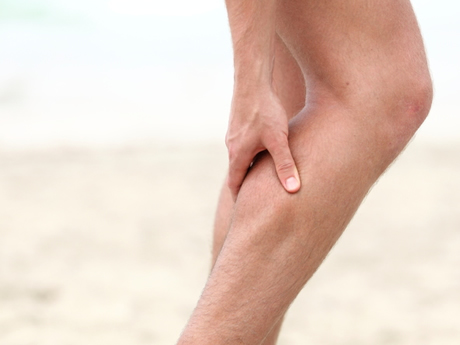Leg pain can affect people in any areas. It can appear as pain from knees to ankles, in the foot, in the knee, behind the knee, in the ankle, down the back of your leg, etc. In most cases, those who have pain from their knee to ankle have lower leg pain. Even though your legs are affected the most by your daily activities, you shouldn’t be in pain. Pain in your lower legs may be due to issues with nerves, blood clots, or a number of other potential problems.

Lower Leg Pain Caused by Bones, Joints, and Muscle Problems
Some of the most common causes of pain from knee to ankle are related to injuries of muscles, joints, and bones.
1. Compartment Syndrome
Compartment syndrome or chronic exertional compartment syndrome occurs if you repeatedly engage in exertional or loading activities. It can affect any lower leg compartments, with the anterior compartment most likely to be affected. Pain in the case of compartment syndrome is typically exercise-induced and you will experience relief with rest. It can also be accompanied by numbness or weakness.
2. Stress Fracture
Stress fractures develop slowly due to repetitive trauma. Eventually, the muscles are overloaded or fatigued to the point where they can’t absorb the shock or stress of repeated impacts and instead begin braking. The stress can transfer to nearby bone, leading to small fractures that aren’t visible on regular X-rays.
3. Medial Tibial Stress Syndrome
Most people know medial tibial stress syndrome as shin splints. This injury commonly affects runners and causes pain from knee to ankle. It occurs due to repeated trauma to your connected muscle tissue by the shinbone (known as the tibia). If you ignore it, this issue can lead to a stress fracture.
4. Periostitis
This condition occurs when the periosteum, the connective tissue surrounding bone, becomes inflamed. It tends to be chronic and will need to be diagnosed separately from shin splints and stress fractures. You can recognize it from the swelling and tenderness of bone along with aching pain. It can be corrected with fixing running mechanics, hip weakness, or improper shoes.
5. Muscle Cramps
Muscle cramps are conditions that at least one of your muscles suddenly and involuntarily contracts. They can be excruciating but are typically harmless. That being said, they do frequently mean that you temporarily can’t use your affected muscle. In some cases, muscle cramps may be due to exercising for long periods of time, especially in hot weather.
6. Achilles Tendonopathy
This condition induces pain in your lower leg, running along the tendon right behind your ankle. It is due to overuse and can cause your tendon to thicken when it heals incorrectly. The pain will have a slow onset and eventually, it will be too painful for you to exercise or the tendon may even rupture.
7. Calf Muscle Tear
This sudden pain takes place in your calf muscle, typically during an activity. It is also known as a calf strain and happens if certain calf muscles become stretched beyond what they can handle. The stretching can lead to tiny microtears in your muscle fibers, more severe injury, or even complete muscle fiber ruptures.
8. Plantaris Tear
Injuries to the plantaris can lead to pain and disability. It may also be referred to tennis leg and occurs if you place too much load on your ankle while your knee is extended. It can happen while jumping, cutting, or running or due to direct trauma to the area.
9. Achilles Tear
This common injury can lead to severe disability. It occurs in sports like basketball and tennis where you frequently push off and cut in the opposite direction. You may be at a higher risk of tears if you have tendonopathy or are between 30 and 40 years old.
10. Tendonitis
This common sports overuse injury can affect anyone. It is when the area around a tendon becomes inflamed and can be triggered by abnormal foot structures like high arches or flat feet. It appears as pain that gets worse if you stretch or use the affected tendon.
Lower Leg Pain Caused by Veins and Nerve Issues
1. Blood Clot
When blood thickens in veins, it can develop a clot. This typically happens in the thigh or lower leg, commonly leading to pain from knee to ankle. There is a higher risk if you are overweight, on certain medicines, or inactive for a long car ride or flight.
2. Varicose Veins
Varicose veins are caused by weakness in the vein walls or valves and can lead to a dull ache, particularly after standing.
3. Lower-Extremity Peripheral Arterial Disease
This occurs if your legs’ arteries get damaged and harden. The legs begin to miss needed blood flow, leading to pain or cramps when walking or climbing stairs.
4. Narrowed Spinal Canal (Stenosis) and Sciatica
When the spinal canal narrows due to a herniated disc, arthritis of the spine, or another cause, it can lead to weakness, fatigue, numbness, tingling, or cramping, burning leg pain when you sit or stand. It may start in the hip and the back before extending down the leg.
5. Diabetic Neuropathy
This diabetes complication can be due to high blood sugar levels and leads to pain in both legs. It also features less sensation and numbness in lower legs.
When to See a Doctor
You should see your doctor for pain from knee to ankle if you have the following symptoms:
- Severe pain on injured ankle or shin, particularly when walking
- Severe swelling in lower leg or surrounding muscles and joints
- Altered feelings in foot or shins, like numbness or pins and needles
- Obvious deformity of bones
- Unable to complete normal daily activities following the first 72 hours
